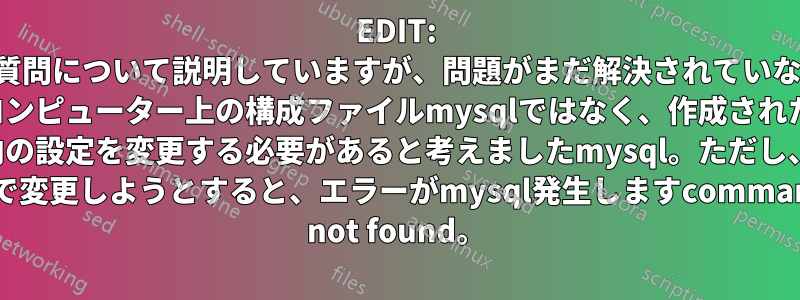
EDIT: 以下は私の最初の質問について説明していますが、問題がまだ解決されていない限り、ローカル コンピューター上の構成ファイルmysqlではなく、作成された POD内の設定を変更する必要があると考えましたmysql。ただし、POD 内で変更しようとすると、エラーがmysql発生しますcommand not found。
次のように、クラスター上で実行されているmysqlイメージをローカルにデプロイしようとしました。KubernetesKind
試して以下のようにkubectl create secret generic mysql-secret --from-literal MYSQL_KEY=11111作成しました:mysql-server
mysql-secret Opaque 1 3d21h
これはmysql-pv.yamlファイルです:
apiVersion: v1
kind: PersistentVolumeClaim
metadata:
name: mysql-pv-claim
spec:
storageClassName: manual
accessModes:
- ReadWriteOnce
resources:
requests:
storage: 20Gi
---
apiVersion: v1
kind: PersistentVolume
metadata:
name: mysql-pv-volume
labels:
type: local
spec:
storageClassName: manual
capacity:
storage: 20Gi
accessModes:
- ReadWriteOnce
hostPath:
path: "/mnt/data"
実行したkubectl apply -f mysql-pv.yamlところ、正常に作成されました。
This is `mysql-depl.yaml` file:
apiVersion: apps/v1
kind: Deployment
metadata:
name: mysql
spec:
selector:
matchLabels:
app: mysql
strategy:
type: Recreate
template:
metadata:
labels:
app: mysql
spec:
containers:
- image: mysql
name: mysql
env:
- name: MYSQL_ROOT_PASSWORD
valueFrom:
secretKeyRef:
name: mysql-secret
key: MYSQL_KEY
ports:
- containerPort: 3306
name: mysql
volumeMounts:
- name: mysql-persistent-storage
mountPath: /var/lib/mysql
volumes:
- name: mysql-persistent-storage
persistentVolumeClaim:
claimName: mysql-pv-claim
---
apiVersion: v1
kind: Service
metadata:
name: mysql
spec:
ports:
- port: 3306
selector:
app: mysql
clusterIP: None
実行したkubectl apply -f mysql-depl.yamlところ、正常に作成されました。
しかし、 thenコマンドmysqlを使用して関連ポッド内で実行したい場合、パスワードの入力を求められ、パスワード ( ) を入力すると次のメッセージが表示されます。kubectl exec -it <mysql-pod-name> shmysql -p11111
ERROR 2002 (HY000): Can't connect to local MySQL server through socket '/var/run/mysqld/mysqld.sock' (2)
内容は次のとおりです/etc/mysql/my.cnf:
#
# The MySQL database server configuration file.
#
# You can copy this to one of:
# - "/etc/mysql/my.cnf" to set global options,
# - "~/.my.cnf" to set user-specific options.
#
# One can use all long options that the program supports.
# Run program with --help to get a list of available options and with
# --print-defaults to see which it would actually understand and use.
#
# For explanations see
# http://dev.mysql.com/doc/mysql/en/server-system-variables.html
#
# * IMPORTANT: Additional settings that can override those from this file!
# The files must end with '.cnf', otherwise they'll be ignored.
#
!includedir /etc/mysql/conf.d/
!includedir /etc/mysql/mysql.conf.d/
内部には次の/etc/mysql/conf.d/2 つのファイルがあります。mysql.cnf
[mysql]
socket = /var/run/mysqld/mysqld.sock
[client]
socket = /var/run/mysqld/mysqld.sock
そしてmysqldump.cnf次のようになります:
[mysqldump]
quick
quote-names
max_allowed_packet = 16M
また/etc/mysql/mysql.conf.d/、ディレクトリ内には 2 つのファイルがありますmysql.cnf。
#
# The MySQL database client configuration file
#
# Ref to https://dev.mysql.com/doc/refman/en/mysql-command-options.html
[mysql]
socket = /var/run/mysqld/mysqld.sock
[client]
socket = /var/run/mysqld/mysqld.sock
そしてmysqld.cnf:
#
# The MySQL database server configuration file.
#
# One can use all long options that the program supports.
# Run program with --help to get a list of available options and with
# --print-defaults to see which it would actually understand and use.
#
# For explanations see
# http://dev.mysql.com/doc/mysql/en/server-system-variables.html
# Here is entries for some specific programs
# The following values assume you have at least 32M ram
[mysqld]
#
# * Basic Settings
#
user = mysql
pid-file = /var/run/mysqld/mysqld.pid
socket = /var/run/mysqld/mysqld.sock
port = 3306
datadir = /var/lib/mysql
# If MySQL is running as a replication slave, this should be
# changed. Ref https://dev.mysql.com/doc/refman/8.0/en/server-system-variables.html#sysvar_tmpdir
# tmpdir = /tmp
#
# Instead of skip-networking the default is now to listen only on
# localhost which is more compatible and is not less secure.
bind-address = 127.0.0.1
mysqlx-bind-address = 127.0.0.1
#
# * Fine Tuning
#
key_buffer_size = 16M
# max_allowed_packet = 64M
# thread_stack = 256K
# thread_cache_size = -1
# This replaces the startup script and checks MyISAM tables if needed
# the first time they are touched
myisam-recover-options = BACKUP
# max_connections = 151
# table_open_cache = 4000
#
# * Logging and Replication
#
# Both location gets rotated by the cronjob.
#
# Log all queries
# Be aware that this log type is a performance killer.
# general_log_file = /var/log/mysql/query.log
# general_log = 1
#
# Error log - should be very few entries.
#
log_error = /var/log/mysql/error.log
#
# Here you can see queries with especially long duration
# slow_query_log = 1
# slow_query_log_file = /var/log/mysql/mysql-slow.log
# long_query_time = 2
# log-queries-not-using-indexes
#
# The following can be used as easy to replay backup logs or for replication.
# note: if you are setting up a replication slave, see README.Debian about
# other settings you may need to change.
# server-id = 1
# log_bin = /var/log/mysql/mysql-bin.log
# binlog_expire_logs_seconds = 2592000
max_binlog_size = 100M
# binlog_do_db = include_database_name
# binlog_ignore_db = include_database_name
さらに、 内に次のファイルがあります/var/run/mysqld/:
mysqld.pid mysqld.sock mysqld.sock.lock mysqlx.sock mysqlx.sock.lock
答え1
mysql コンテナのパスワード環境変数を忘れたようです。この手順をもう一度確認してください。
答え2
このエラーは、物理ストレージ上のソケット ファイル (mysql.sock) とコンテナー内の /var/run/mysqld/mysqld.sock 間のシンボリック リンクが壊れている場合に発生する可能性があります。
物理ストレージは /var/lib/mysql にマウントされるため、コンテナー内の /var/lib/mysql/mysql.sock に mysql.sock ファイルがあります。
もしそうなら:
mysqlコンテナにexecしてbashプロンプトを取得します
'ln -s /var/lib/mysql/mysql.sock /var/run/mysqld/mysqld.sock' を実行します。
次に、mysql -u -p ...などを実行してログインします。
MySQL ワークベンチがまだ満足できない場合は、「flush hosts」を実行する必要があるかもしれません。


